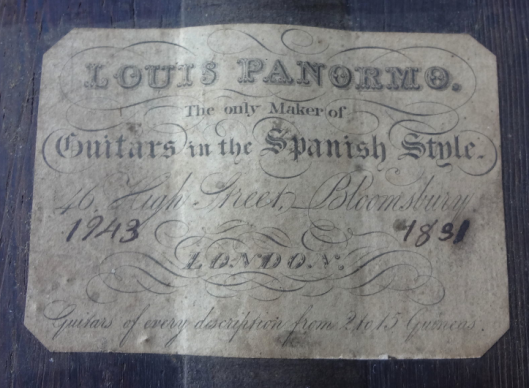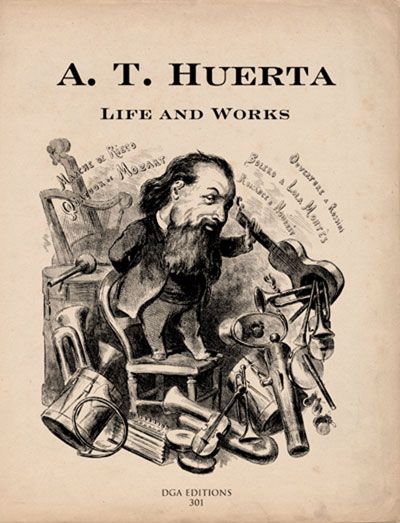Tags
Street View: 27
Address: 46 High Street, Bloomsbury
In the first quarter of the nineteenth century, the six-stringed guitar was introduced into England and one of the best maker of such guitars was Louis Panormo. His father, Vicenzo Panormo (1734-1813), originally a violin maker from Sicily, came to London via France with his four sons. The whole family was musically minded and many Panormos found work in London as instrument makers, musicians, music publishers and composers. There were to begin with Vicenzo’s four sons, Francis (1763-1843), Joseph (1768-1837), George (1776-1852) and Louis (1784-1862), but the next generation, Ferdinand (c.1795-1882), Robert (c.1803-1873), Edward (1811-1891), George Lewis (1815-1877) and Angelina (1811-1900) were also involved in the world of music. George Lewis, the son of George, will figure later in the story of Louis’ business. Louis styled himself “the only maker of guitars in the Spanish style”. Whether that was true is debatable, but it made a good advertorial phrase and he had it printed above the elevation of his shop in the Tallis Street View.
The labels Louis put in his guitars included his address, so it is possible to trace were his shops were situated. The earliest label of 1816 puts him at 26 High Street, but he moved to number 46 in 1828 where he remained until c.1846-7. He also had shops at number 40 High Street (1829-c.1832-3), at 6 Greek Street (1837-1840) and a short-lived one at 22 Compton Street (1847). From 1847-c.1854 he worked from 31 High Street. Tallis calls it High Street, Bloomsbury, but it is now better known as St. Giles High Street. Although the labels suggest he started his career in 1816, the advertisement he had in Street View 27 claims that he had already been working for thirty years which would date the start of his career at ±1809. His daughter Angelina (also Angiolina) was baptised on 1 March 1812 (date of birth 19 July 1811) at St. Pancras Old Church which suggests another area of the city, athough no specific address is given. When daughter Anna Maria is baptised at St. Giles in the Fields on 5 September 1813, the address of 43 Mortimer Street is given, but it is unclear whether he ever had a shop there. The name of the mother of these two girls was Ann, but that is all I know about her. When the next daughter, Mathilda, is baptised, the mother is listed as Sarah and the address is High Street, which does correspond to the guitar labels. More children were born to Louis and Sarah and when addresses are given in the baptismal records, they correspond to those on the guitar labels. Why Louis married Sarah Sutton only in 1834, many years after the children were born, remains a mystery. We also know that he rented a stable in Falconbery Court from where some riding material was stolen in April 1836.(1)
Panormo’s guitars became quite famous and Major William Charles Yelverton wrote to Theresa Longworth,
“I forget whether guitar playing is one of your musical accomplishments; but having just heard of one of said instruments going for the sum which a music-seller in this town has pleased to offer for it, and which, I presume, is, according to trade custom, far under its value, I have persuaded the lady wanting to sell it to wait a day or two until I could hear from you whether you would promise to play the said guitar if I get it for you … I should have told you that the guitar was made by ‘Louis Panormo;’ not that I ever heard his name before, but they tell me he was a great man in his own line”.(2)
Two days later, the paper continues the letter conversation and Miss Yelverton wrote rather despondently “If you have got the guitar I will learn it, in the hope of doing something to please you, having hitherto failed in all my accomplishments”. Whether the Major bought the instrument and whether Theresa did indeed learn to play the guitar is unclear, but what is clear, is that Panormo’s name as a guitar maker was apparently highly regarded in Ireland from where Yelverton wrote his letter.

Six string guitar, labelled ‘Louis Panormo, London’, inlaid with mother of pearl (Source: National Trust Collection inv.nr. 836071)
The famous Spanish guitarist Antonio Trinitario Huerta (1800-1874) had come to England in 1827 and played on a guitar made by Panormo. This seems to have been a mutual benificial arrangement; the famous guitarist using a guitar made by London’s famous guitar maker. Panormo published Huerta’s Divertimentos which were dedicated to his student, Louis’ daughter Angelina. She married Huerta in 1828 when she was only 17 years old and the couple lived in Paris for a while, teaching the guitar, she to the ladies, he to the men. But ten years later, Angelina was back in London with her children while Huerta lived – apparently separately – at Brighton.
In 1859, Louis, his wife Sarah and three of their children took the boat to New Zealand to settle in Orua Bay (close to Auckland). They were not the first of the family to emigrate; three sons and two daughters had gone to Australia in 1853, but later joined the rest of the family in New Zealand. Nephew George Lewis continued the business of musical instrument maker in St. Giles High Street and later at 87 St. John Street, Fitzroy Square and in Whitefield Street until his death in 1877.(3)

No 1 from Huerta’s Four Divertimentos played by Taro Takeuchi on a Panormo guitar, albeit not one made by Louis, but by Edward (click to start the music)
———
Information that has not been given a footnote, came from Gary Southwell, The Panormo Guitar and its Makers, London College of Furniture (1983; online here) and James Westbrook, “Louis Panormo: ‘The only Maker of Guitars in the Spanish Style'” in Early Music, vol. XLI, no. 4 (2013).
(1) Old Bailey Case t18360404-1029. Stolen: 3 saddles, 1 pair of traces, 1 pair of harnes, 1 breeching, 1 bridle, 1 pair of reigns, 1 martingale and 1 horse-cloth. Total value 79s.
(2) Freeman’s Journal and Daily Commercial Advertser, The Longworth-Yelverton Letters, 10 January 1863. Date of the actual letter not stated. See the Wikipedia pages for Yelverton and Longworth.
(3) England & Wales, National Probate Calendar (Index of Wills and Administrations), 1877.
Neighbours:
| <– 47 High Street | 45 High Street –> |







Pingback: Anthony Brown, musical instrument maker | London Street Views